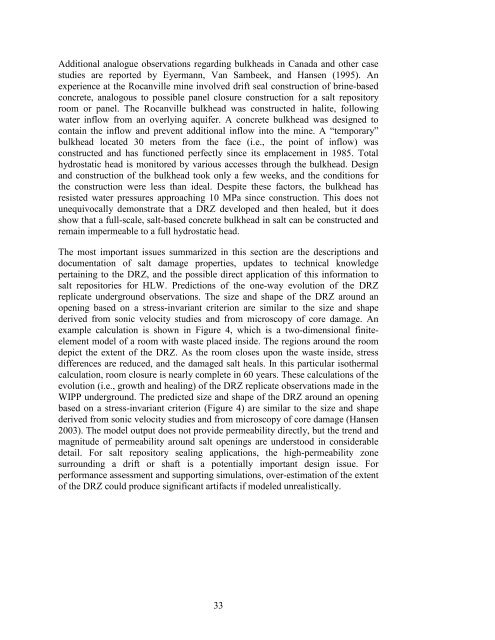Salt Disposal of Heat-Generating Nuclear Waste
Salt Disposal of Heat-Generating Nuclear Waste
Salt Disposal of Heat-Generating Nuclear Waste
Create successful ePaper yourself
Turn your PDF publications into a flip-book with our unique Google optimized e-Paper software.
Additional analogue observations regarding bulkheads in Canada and other case<br />
studies are reported by Eyermann, Van Sambeek, and Hansen (1995). An<br />
experience at the Rocanville mine involved drift seal construction <strong>of</strong> brine-based<br />
concrete, analogous to possible panel closure construction for a salt repository<br />
room or panel. The Rocanville bulkhead was constructed in halite, following<br />
water inflow from an overlying aquifer. A concrete bulkhead was designed to<br />
contain the inflow and prevent additional inflow into the mine. A “temporary”<br />
bulkhead located 30 meters from the face (i.e., the point <strong>of</strong> inflow) was<br />
constructed and has functioned perfectly since its emplacement in 1985. Total<br />
hydrostatic head is monitored by various accesses through the bulkhead. Design<br />
and construction <strong>of</strong> the bulkhead took only a few weeks, and the conditions for<br />
the construction were less than ideal. Despite these factors, the bulkhead has<br />
resisted water pressures approaching 10 MPa since construction. This does not<br />
unequivocally demonstrate that a DRZ developed and then healed, but it does<br />
show that a full-scale, salt-based concrete bulkhead in salt can be constructed and<br />
remain impermeable to a full hydrostatic head.<br />
The most important issues summarized in this section are the descriptions and<br />
documentation <strong>of</strong> salt damage properties, updates to technical knowledge<br />
pertaining to the DRZ, and the possible direct application <strong>of</strong> this information to<br />
salt repositories for HLW. Predictions <strong>of</strong> the one-way evolution <strong>of</strong> the DRZ<br />
replicate underground observations. The size and shape <strong>of</strong> the DRZ around an<br />
opening based on a stress-invariant criterion are similar to the size and shape<br />
derived from sonic velocity studies and from microscopy <strong>of</strong> core damage. An<br />
example calculation is shown in Figure 4, which is a two-dimensional finiteelement<br />
model <strong>of</strong> a room with waste placed inside. The regions around the room<br />
depict the extent <strong>of</strong> the DRZ. As the room closes upon the waste inside, stress<br />
differences are reduced, and the damaged salt heals. In this particular isothermal<br />
calculation, room closure is nearly complete in 60 years. These calculations <strong>of</strong> the<br />
evolution (i.e., growth and healing) <strong>of</strong> the DRZ replicate observations made in the<br />
WIPP underground. The predicted size and shape <strong>of</strong> the DRZ around an opening<br />
based on a stress-invariant criterion (Figure 4) are similar to the size and shape<br />
derived from sonic velocity studies and from microscopy <strong>of</strong> core damage (Hansen<br />
2003). The model output does not provide permeability directly, but the trend and<br />
magnitude <strong>of</strong> permeability around salt openings are understood in considerable<br />
detail. For salt repository sealing applications, the high-permeability zone<br />
surrounding a drift or shaft is a potentially important design issue. For<br />
performance assessment and supporting simulations, over-estimation <strong>of</strong> the extent<br />
<strong>of</strong> the DRZ could produce significant artifacts if modeled unrealistically.<br />
33
















